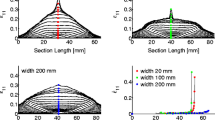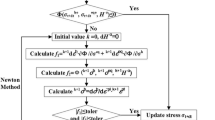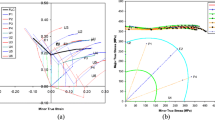Abstract
Despite their large industrial use, Forming Limit Diagrams can describe the material formability only under single-stroke deformations, but they can dramatically fail when the deformation is not linear or incremental as it happens in many sheet forming processes. So, the need of alternative approaches is particularly significant in order to have a more general and effective description of the material formability. The paper focuses on the use of the Generalized Incremental Stress-State dependent damage MOdel (GISSMO) to predict the formability in 22MnB5 hot stamping. The model was calibrated on the basis of laboratory experiments carried out at high temperature, and the results validated on a laboratory simulative tests of stretching at high temperatures, namely 700 °C and 800 °C, showing a good agreement between numerical and experimental results.



















Similar content being viewed by others
References
ISO copyright office (2006) Metallic materials-sheet and strip-determination of forming limit curves-Part 2: determination of forming limit curves in laboratory, ISO/DIS 12004-2
Marciniak Z, Kuczynski K. Limit strains in the process of stretch-forming sheet metal. Int J Mech Sci 9:609–620
Nakazima K, Kikuma T, Asaku K (1968) Study on the formability of steel sheet. Yawata Tech Rep 264
Bergström Y, Ölund S (1982) The forming limit diagram of sheet metals and effects of strain path changes on formability: a dislocation treatment. Mater Sci Eng 56:47–61
Nurcheshmeh M, Green DE (2011) Investigation on the strain-path dependency of stress-based forming limit curves. IntJ Mater Form 4:25. https://doi.org/10.1007/s12289-010-0989-4
Graf A, Hosford WF (1993) Effect of changing strain paths on forming limit diagrams of AI 2008-T4. Metall Trans A 24:2497–2501
Yao H, Cao J (2002) Prediction of forming limit curves using an anisotropic yield function with pre-strain induced back-stress. Int J Plast 18(8):1013–1038
Stoughton TB, Zhu X (2004) Review of theoretical models of the strain-based FLD and their relevance to the stress-based FLD. Int J Plast 20(8-9):1463–1486
Hora P, Tong L (2006) Numerical prediction of FLC using the enhanced modified maximum force criterion. In: Hora P (ed) Proceedings of FLC-Zurich 06, Zurich, pp 31–36
Volk Wolfram, Suh Joungsik (2013) Prediction of formability for non-linear deformation history using generalized forming limit concept (GFLC). AIP Conf Proc 1567:556
Andrade F, Feucht M (2017) A comparison of damage and failure models for the failure prediction of dual-phase steel. In: 11th European LS_DYNA Conference 2017
Gurson AL (1977) Continuum theory of ductile rupture by void nucleation and growth: Part I. Yield criteria and flow rules for porous ductile media. J Eng Mater Technol 99(1):2–15
Tvergaard V (1981) Influence of voids on shear band instabilities under plane strain conditions. Int J Fract 157:55–69
Tvergaard V, Needleman A (1995) Effects of nonlocal damage in porous plastic solids. Int J Solids Struct 32(8/9):1063–1077
Cockroft MG, Latham DJ (1968) Ductility and workability of metals. J Inst Metals 96:33–39
Neukamm F et al (2016) On closing the constitutive gap between forming and crash simulation. 10th Int J Fract 200:127
Andrade FXC et al (2016) An incremental stress state dependent damage model for ductile fracture prediction. Int J Fract 200:127
Andrade F, Erhart T, Haufe A (2016) Modeling of anisotropic damage with *MAT_ADD_GENERALIZED_DAMAGE, DynaMore, October 13th, 2016
Golling S, Östlund R, Schill M, Sjöblom R, Mattiasson K, Jergeus J, Oldenburg M (2017) A comparative study of different failure modeling strategies on a laboratory scale test component. In: 2017 CHS2 conference proceedings
Wang QL, Ghiotti A, Bruschi S (2018) Anisotropy influence on the failure of Ti6Al4V sheets deformed at room and elevated temperature. AIP Conf Proc 1960:160030
Wang QL, Ghiotti A, Bruschi S, Mu Y (2019) Modelling of fracture occurrence in Ti6Al4V sheets at elevated temperature accounting for anisotropic behaviour. Int J Mech Sci 150:471–483
Stander N, Roux WJ, Goel T, Eggleston T, Craig KJ (2010) LS_OPT version 4.1 user’s man- ual. Livermore Software Technology Corporation
Stander N, Craig KJ (2002) On the robustness of a simple domain reduction scheme for simulation-based optimization. Eng Comut 19:431–450
Yin Q, Zillmann B, Suttner S, Gerstein G, Biasutti M, Tekkaya AE, Wagner MF-X, Merklein M, Schaper M, Halle T, Brosius A (2014) Int J Solids Struct 51:1066–1074
Akerstrom P, Oldemburg M (2006) Austenite decomposition during press hardening of a Boron Steel—computer simulation and test. J Mater Process Tech 174:399–406
Funding
This work was funded by Ford Motor Company (Grant number 2014-4050 URP).
Author information
Authors and Affiliations
Corresponding author
Additional information
Publisher's Note
Springer Nature remains neutral with regard to jurisdictional claims in published maps and institutional affiliations.
Rights and permissions
About this article
Cite this article
Venturato, G., Ghiotti, A. & Bruschi, S. Stress-state dependent formability modelling in hot stamping. Prod. Eng. Res. Devel. 14, 105–114 (2020). https://doi.org/10.1007/s11740-019-00941-z
Received:
Accepted:
Published:
Issue Date:
DOI: https://doi.org/10.1007/s11740-019-00941-z




